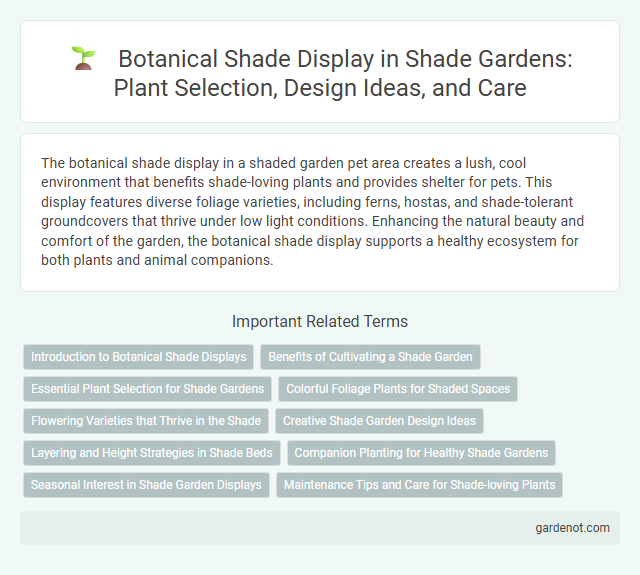The botanical shade display in a shaded garden pet area creates a lush, cool environment that benefits shade-loving plants and provides shelter for pets. This display features diverse foliage varieties, including ferns, hostas, and shade-tolerant groundcovers that thrive under low light conditions. Enhancing the natural beauty and comfort of the garden, the botanical shade display supports a healthy ecosystem for both plants and animal companions.
Introduction to Botanical Shade Displays
Botanical shade displays showcase a diverse collection of shade-loving plants adapted to low-light environments, emphasizing species such as ferns, hostas, and woodland wildflowers. These displays demonstrate how shade gardens can thrive under tree canopies or on north-facing slopes, highlighting plant morphology and growth habits suited to shaded habitats. Understanding the interplay of light, soil moisture, and plant selection is essential for designing successful and sustainable botanical shade displays.
Benefits of Cultivating a Shade Garden
Cultivating a shade garden enhances biodiversity by providing a habitat for shade-tolerant plants such as hostas, ferns, and astilbes, which thrive under low light conditions. Shade gardens improve soil health by reducing evaporation and promoting moisture retention, creating a cooler microclimate that supports diverse plant growth. These gardens also offer aesthetic value with lush greenery and textured foliage, contributing to a tranquil outdoor environment ideal for relaxation and ecological balance.
Essential Plant Selection for Shade Gardens
Selecting essential plants for a shade garden involves prioritizing species adapted to low-light conditions, such as hostas, ferns, and astilbes, which thrive under dense canopy cover. Botanical shade displays benefit from incorporating diverse foliage textures and varying growth habits to enhance visual interest and ecological balance. Emphasizing native shade-tolerant perennials and groundcovers supports local biodiversity and sustainable garden management.
Colorful Foliage Plants for Shaded Spaces
Botanical shade displays highlight a diverse range of colorful foliage plants such as Heuchera, Caladium, and Tiarella, which thrive in low light conditions. These plants offer vibrant hues from deep purples and rich reds to bright greens and variegated patterns, enriching shaded garden areas with visual interest. Incorporating species like Japanese Painted Fern and Coleus ensures year-round color and texture in shaded landscapes, optimizing botanical diversity and aesthetic appeal.
Flowering Varieties that Thrive in the Shade
Botanical shade gardens showcase a diverse collection of flowering varieties such as Astilbe, Hellebores, and Tiarella, which thrive in low-light conditions. These shade-loving plants offer vibrant blooms and lush foliage that enhance garden aesthetics despite minimal sunlight. Incorporating species like Solomon's Seal and Bleeding Hearts ensures continuous flowering and seasonal interest in shaded garden areas.
Creative Shade Garden Design Ideas
Botanical shade displays showcase a diverse collection of plants like hostas, ferns, and bleeding hearts that thrive in low-light conditions, creating lush, textured landscapes. Creative shade garden design ideas incorporate layered planting, using varying foliage shapes and colors to enhance visual interest while optimizing limited sunlight. Integrating natural elements such as stone pathways, woodland accents, and shaded seating areas maximizes both functionality and aesthetic appeal in shaded garden spaces.
Layering and Height Strategies in Shade Beds
Layering and height strategies in shade beds enhance the botanical shade garden by creating depth and visual interest through carefully arranged plant heights and textures. Utilizing understory plants like ferns and hostas beneath taller shade-tolerant trees such as dogwoods or maples maximizes space and mimics natural forest layering. Strategic layering improves microclimates within the garden, promoting healthier growth and increased biodiversity in shade environments.
Companion Planting for Healthy Shade Gardens
Companion planting in botanical shade gardens enhances plant health by combining species that thrive under low-light conditions, such as ferns, hostas, and astilbes. Strategic pairing of nitrogen-fixing plants like woodland legumes with shade-loving perennials improves soil fertility naturally, promoting vigorous growth and disease resistance. Incorporating diverse plant families supports microclimate regulation and pest control, ensuring a sustainable and vibrant shade garden ecosystem.
Seasonal Interest in Shade Garden Displays
Botanical shade displays showcase a diverse range of shade-tolerant plants that provide vibrant seasonal interest through varying foliage colors, textures, and bloom times. Incorporating ferns, hostas, astilbes, and shade-loving perennials enhances visual appeal from spring to fall. Seasonal layering with evergreen shrubs like holly or rhododendrons maintains structure during winter months, ensuring year-round garden intrigue.
Maintenance Tips and Care for Shade-loving Plants
Botanical shade displays thrive with proper soil moisture management and periodic mulching to retain humidity, essential for shade-loving plants like hostas and ferns. Regularly removing dead leaves and monitoring for pests such as slugs and aphids ensure healthy growth in shaded environments. Applying balanced, slow-release fertilizers supports nutrient needs without overwhelming delicate shade garden ecosystems.
Botanical shade display Infographic

 gardenot.com
gardenot.com